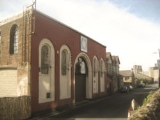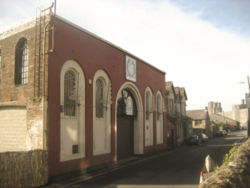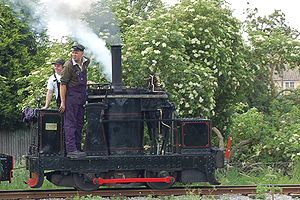
De Winton
Encyclopedia

Caernarfon
Caernarfon is a Royal town, community and port in Gwynedd, Wales, with a population of 9,611. It lies along the A487 road, on the east banks of the Menai Straits, opposite the Isle of Anglesey. The city of Bangor is to the northeast, while Snowdonia fringes Caernarfon to the east and southeast...
, Wales
Wales
Wales is a country that is part of the United Kingdom and the island of Great Britain, bordered by England to its east and the Atlantic Ocean and Irish Sea to its west. It has a population of three million, and a total area of 20,779 km²...
. They built vertical boiler
Vertical boiler
A vertical boiler is a type of fire-tube or water-tube boiler where the boiler barrel is oriented vertically instead of the more common horizontal orientation...
ed narrow gauge locomotives for use in Welsh slate mines
Slate industry in Wales
The slate industry in Wales began during the Roman period when slate was used to roof the fort at Segontium, now Caernarfon. The slate industry grew slowly until the early 18th century, then expanded rapidly until the late 19th century, at which time the most important slate producing areas were in...
and other industrial settings. At least six De Winton locomotives have been preserved. But these quarry tramway locomotives, for which in the 21st century they are largely remembered, were just a small part of this company's engineering output.
Overview

Carnarvonshire Railway
The Carnarvonshire Railway was a railway connecting Caernarvon railway station with Afon Wen.-History:...
was being built under Castle Square, the tunnel roof was supported by iron beams supplied by De Winton's and their name can still be seen at the entrance to the tunnel, which is now used as a road underpass.
The foundry was a major supplier to the Caernarfon and Liverpool ship building industry the firm built engines up to 200HP marine steam engine
Marine steam engine
A marine steam engine is a reciprocating steam engine that is used to power a ship or boat. Steam turbines and diesel engines largely replaced reciprocating steam engines in marine applications during the 20th century, so this article describes the more common types of marine steam engine in use...
powered by boilers that they also made. These marine engines influenced the quarry locomotives that they made over 60 where produced (see www.de-winton.com) over a 25 year period. They also built stationary steam engines and the engine preserved at Parc Glynllifon near Caernarfon is the second oldest working stationary engine in Britain.
De Winton's supplied the quarry industry and made whatever might be needed. At the large and very profitable Dinorwic Quarry
Dinorwic Quarry
The Dinorwic Slate Quarry is a large former slate quarry, now home to the Welsh National Slate Museum, located between the villages of Llanberis and Dinorwig in north Wales. It was the second largest slate quarry in Wales, indeed in the world, after the neighbouring Penrhyn Quarry....
in Llanberis
Llanberis
Llanberis is a village in Gwynedd, North Wales, lying on the southern banks of Llyn Padarn in Snowdonia. It takes its name from Saint Peris, an early Welsh saint.According to the United Kingdom Census 2001, the population of Llanberis was 1,954...
, in 1870, De Winton's built and equipped an entire workshop with machinery powered by overhead shafting that in its turn was driven by the largest water wheel in the United Kingdom (over 50 feet in diameter), which remained in daily use until 1925 when it was replaced by a Pelton wheel but retained as standby. The wheel is the subject of a preservation order but in fact the entire workshop complex is preserved as the National Slate Museum.
Mr Jeffreys Parry de Winton was Mayor of Caernarfon (1870-72) when his company was one of the rising enterprises in the town. The Company remained in his hands and important in Caernarfon's maritime activities until about 1890. In its decline from that time it appears to have been badly managed and heavily committed to a French invention that failed and brought bankruptcy in 1901. Some of the De Winton works in St Helen's Road survives, since 1988 it has been the home of a local Plumbing & Heating business, before that the foundry was used as a bonded warehouse
Bonded warehouse
A Bonded warehouse is a building or other secured area in which dutiable goods may be stored, manipulated, or undergo manufacturing operations without payment of duty. It may be managed by the state or by private enterprise. In the latter case a customs bond must be posted with the government...
and wine merchants. It stands opposite the Caernarfon station
Caernarfon railway station
Caernarfon Station is the northern terminus of the narrow gauge Welsh Highland Railway, located in the town of Caernarfon. It was opened on 11 October 1997 when the line was constructed from Dinas.- History :...
of the Welsh Highland Railway
Welsh Highland Railway
The Welsh Highland Railway is a long restored narrow gauge heritage railway in North Wales, operating from Caernarfon to Porthmadog, and passing through a number of popular tourist destinations including Beddgelert and the Aberglaslyn Pass. At Porthmadog it connects with the Ffestiniog Railway...
.
The steam engine at Glynllifon was restored by the late Fred Dibnah
Fred Dibnah
Frederick "Fred" Dibnah MBE , born in Bolton, was an English steeplejack and eccentric with a keen interest in mechanical engineering who became a cult television personality....
after he was originally called to the park to quote for the demolition of the chimney.
De Winton locomotives
The De Winton records were not preserved, so the complete list of locomotives produced is not known.| Type | Name | Worked at | Built | Gauge | Disposition | Notes |
|---|---|---|---|---|---|---|
| 0-4-0 VB | Wellington | Dinorwic quarry | 1877 | Sold to Glynrhonwy quarry 1898 | double-cylinder engine, double-flanged wheels | |
| 0-4-0 VB | Harriet | Dinorwic quarry | 1874 | Scrapped by 1895 | Single-cylinder engine, double-flanged wheels | |
| 0-4-0 VB | Peris | Dinorwic quarry | 1875 | Sold or Scrapped by 1895 | double-cylinder engine, double-flanged wheels | |
| 0-4-0 VB | Victoria | Dinorwic quarry | 1876 | Scrapped by 1895 | Single-cylinder engine, double-flanged wheels | |
| 0-4-0 VB | Padarn | Dinorwic quarry | unknown | Sold to Glynrhonwy quarry 1898 | Single-cylinder engine, double-flanged wheels | |
| 0-4-0 VB | Rhymney | Pen y Bryn quarry | 1875 | Scrapped | Built for Penrhyn quarry, but order was cancelled | |
| 0-4-0 VB | Lord Penrhyn | Penrhyn quarry | 1876 | Scrapped 1909 | ||
| 0-4-0 VB | Lady Penrhyn | Penrhyn quarry | 1876 | Scrapped 1911 | ||
| 0-4-0 VB | Alice | Penrhyn quarry | 1876 | Scrapped 1912 | ||
| 0-4-0 VB | Georgina | Penrhyn quarry | 1876 | Damaged beyond repair in rockfall 1904 | ||
| 0-4-0 VB | Ina | Penrhyn quarry | 1876 | Scrapped 1911 | ||
| 0-4-0 VB | Baladeulyn | Pen-yr-orsedd Quarry tramways Pen-yr-Orsedd Quarry tramways The Pen-yr-Orsedd Quarry tramways were the industrial narrow gauge railways serving the Pen-yr-Orsedd slate quarry and connecting them to the Nantlle Railway... |
Sold to Glynrhonwy Slate Quarry in 1895 | |||
| 0-4-0 VB | Starstone | Pen-yr-orsedd Quarry tramways Pen-yr-Orsedd Quarry tramways The Pen-yr-Orsedd Quarry tramways were the industrial narrow gauge railways serving the Pen-yr-Orsedd slate quarry and connecting them to the Nantlle Railway... |
. | |||
| 0-4-0 VB | Inverlochy | Pen-yr-orsedd Quarry tramways Pen-yr-Orsedd Quarry tramways The Pen-yr-Orsedd Quarry tramways were the industrial narrow gauge railways serving the Pen-yr-Orsedd slate quarry and connecting them to the Nantlle Railway... |
1877 | Possible ex-Pen-y-Bryn Quarry. Scrapped 1937 | ||
| 0-4-0 VB | Glynllifon | Pen-yr-orsedd Quarry tramways Pen-yr-Orsedd Quarry tramways The Pen-yr-Orsedd Quarry tramways were the industrial narrow gauge railways serving the Pen-yr-Orsedd slate quarry and connecting them to the Nantlle Railway... |
1880 | Scrapped 1937 | ||
| 0-4-0 VB | Rhymney | Pen-yr-orsedd Quarry tramways Pen-yr-Orsedd Quarry tramways The Pen-yr-Orsedd Quarry tramways were the industrial narrow gauge railways serving the Pen-yr-Orsedd slate quarry and connecting them to the Nantlle Railway... ex-Penybryn Penybryn Penybryn is a small village situated near Gelligaer in the County Borough of Caerphilly, Wales.... |
1875 | Scrapped 1933 | ||
| 0-4-0 VB | Chaloner Chaloner (locomotive) 0-4-0VBT Chaloner is an example of de Winton's distinctive vertical-boilered design, as used for many years in the North Wales slate quarries. It was built in 1877 at the Union Works in Caernarfon.... |
Pen-yr-orsedd Quarry tramways Pen-yr-Orsedd Quarry tramways The Pen-yr-Orsedd Quarry tramways were the industrial narrow gauge railways serving the Pen-yr-Orsedd slate quarry and connecting them to the Nantlle Railway... ex-Penybryn Penybryn Penybryn is a small village situated near Gelligaer in the County Borough of Caerphilly, Wales.... |
1877 | Sold to a private collector 1960; now preserved at the Leighton Buzzard Light Railway Leighton Buzzard Light Railway The Leighton Buzzard Light Railway is a narrow gauge light railway in Leighton Buzzard in Bedfordshire, England. It operates on a gauge, and is just under long. The line was built after the First World War to serve sand quarries north of the town... . |
||
| 0-4-0 VB | Kathleen | Penrhyn quarry | 1877 | Preserved at the Phyllis Rampton Trust Phyllis Rampton Trust The Phyllis Rampton Narrow Gauge Railway Trust is a British charity which is registered with the British Charity Commission as 292240 under the classification of "Education/TrainingEnvironment/Conservation/Heritage"... Aberystwyth |
||
| 0-4-0 VB | George Henry | Penrhyn quarry | 1877 | Preserved at the Narrow Gauge Railway Museum, Tywyn | ||
| 0-4-0 ST | Edward Sholto | Penrhyn Quarry Railway | 1876 | Scrapped 1907 | One of only three horizontally boilered locos known to have been built by de Wintons, all supplied to Penrhyn. | |
| 0-4-0 ST | Hilda | Penrhyn Quarry Railway | 1878 | Scrapped after 1911 | One of only three horizontally boilered locos known to have been built by de Wintons, all supplied to Penrhyn. | |
| 0-4-0 ST | Violet | Penrhyn Quarry Railway | 1879 | Scrapped before 1911 | One of only three horizontally boilered locos known to have been built by de Wintons, all supplied to Penrhyn. | |
| 0-4-0 VB | Penmaen | Penmaenmawr & Welsh Granite Co. Ltd. | 1878 | Remains still in situ in quarry | Out of use by 1943 | |
| 0-4-0 VB | Lillian | Penmaenmawr & Welsh Granite Co. Ltd. | 1891 | Out of use by 1933; scrapped | ||
| 0-4-0 VB | Louisa | Penmaenmawr & Welsh Granite Co. Ltd. | 1892 | Out of use by 1936; scrapped 1951 | ||
| 0-4-0 VB | Ada | Penmaenmawr & Welsh Granite Co. Ltd. | 1892 | Out of use by 1931; scrapped | ||
| 0-4-0 VB | Gelli | Pen-yr-orsedd Quarry tramways Pen-yr-Orsedd Quarry tramways The Pen-yr-Orsedd Quarry tramways were the industrial narrow gauge railways serving the Pen-yr-Orsedd slate quarry and connecting them to the Nantlle Railway... |
1893 | Withdrawn 1945, still intact at quarry 1952; believed scrapped, frame used as part of pit in loco shed. Subsequently removed for preservation. | ||
| 0-4-0 VB | Puffin | Penmaenmawr & Welsh Granite Co. Ltd. | 1893 | Out of use by 1934 | ||
| 0-4-0 VB | Watkin | Penmaenmawr & Welsh Granite Co. Ltd. | 1893 | Out of use by 1944 | ||
| 0-4-0 VB | Harold | Penmaenmawr & Welsh Granite Co. Ltd. | 1894 | Out of use by 1936; scrapped 1951 | ||
| 0-4-0 VB | Pendyffryn | Penyrorsedd slate quarry | 1894 | Privately owned; awaiting restoration at the Brecon Mountain Railway Brecon Mountain Railway The Brecon Mountain Railway is a narrow gauge preserved railway that runs through the Brecon Beacons along the full length of the Pontsticill Reservoir... |
||
| 0-4-0 VB | Llanfair | Penmaenmawr & Welsh Granite Co. Ltd. | 1895 | At the Welsh Highland Railway Welsh Highland Railway The Welsh Highland Railway is a long restored narrow gauge heritage railway in North Wales, operating from Caernarfon to Porthmadog, and passing through a number of popular tourist destinations including Beddgelert and the Aberglaslyn Pass. At Porthmadog it connects with the Ffestiniog Railway... |
Out of use by 1940 | |
| 0-4-0 VB | Arthur | Pen-yr-orsedd Quarry tramways Pen-yr-Orsedd Quarry tramways The Pen-yr-Orsedd Quarry tramways were the industrial narrow gauge railways serving the Pen-yr-Orsedd slate quarry and connecting them to the Nantlle Railway... |
1895 | Scrapped 1956 | ||
| 0-4-0 VB | Victoria | Pen-yr-orsedd Quarry tramways Pen-yr-Orsedd Quarry tramways The Pen-yr-Orsedd Quarry tramways were the industrial narrow gauge railways serving the Pen-yr-Orsedd slate quarry and connecting them to the Nantlle Railway... |
1897 | Scrapped 1956 | ||

